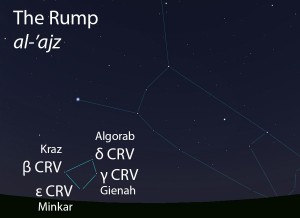Star Names
The Rump (al-‘ajz)
The Rump is part of the Arabian megaconstellation of the Lion (al-asad). It lies well south of the rest of the Lion, so it may have been a later addition to the figure.

The Rump (al-‘ajz) as it appears setting in the west about 45 minutes before sunrise in mid-March. Sky simulations made with Stellarium.
Appearance
A grouping of four moderately bright stars that is arranged in a quadrilateral shape.
Modern Identification
β CRV (Kraz), yellow giant star, magnitude 2.7
δ CRV (Algorab), white double star, magnitudes 3.0 and 8.4
γ CRV (Gienah), blue-white star, magnitude 2.6
ε CRV (Minkar), yellow star, magnitude 3.0
Timing
The four stars of the Rump set over the course of a week and a half, beginning just before the setting of the Mane (az-zubra). Ibn Qutayba (d. 879 CE) reported that the Mane was said to rise on the morning of August 28 and set on the morning of February 26. On account of the precession of the equinoxes, today we can expect to observe the Rump setting in mid to late April, and rising in mid to late October, as seen from the latitude of Tucson. (See How to Observe on the About page for more on this topic.)
Rain Stars
The Rump of the Lion does not figure in the calendar of the rains stars.
Lunar Stations
The Rump of the Lion is not one of the lunar stations.
Related Stars and Celestial Complexes
The Rump is part of the Lion (al-asad, الأسد) folkloric celestial complex, which extends from the Two Forearms (adh-dhira’an, الذراعان) to the Two Shanks (as-saqan, الساقان).
Related Blog Posts
The Setting of the Arabian Sky-Raisers

